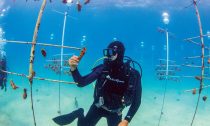
When ecologist Carly Randall first dove into the waters of the Great Barrier Reef in 2017, she was bracing herself for the worst. During the prior year or so, the reef had been ravaged by back-to-back heat waves and an invasion of crown-of-thorns.
When corals get too hot, they release the algae that live in their cells and provide them with nutrients, turning the corals white and sometimes causing them to starve. And crown-of-thorns starfish, which look like hostile creatures from a B movie, feast on reef-building corals, leaving behind skeletons.
But rather than a disintegrating ecosystem reminiscent of a horror flick, Randall saw a reef full of vibrant corals, teeming with fish and other aquatic life. “What did they even hire me to do restoration for? This reef looks amazing,” she remembers wondering. Randall had just moved from the US to the Australian Institute of Marine Science to help fight the effects of climate change on the reef.
But it turns out that Randall just happened to take her first dive in a healthy area of the reef. The Great Barrier Reef covers a 344,400 km2zone, about the area of the entire country of Japan. Plenty of other sites looked grim.
Climate change poses an existential threat to the world’s coral reefs as well as to the ocean ecosystems and human economies they support. The situation is more urgent in the tropics, where water temperatures are warmer on average and warming seas are pushing corals to their limits. Still, Randall thinks back on that first dive and has hope: “There are still so many reefs that look incredible; there are places that are healthy and vibrant.”
The resilience on display in those reefs is what’s inspiring scientists in Australia, the Caribbean, and all around the world to figure out how some corals have adapted to survive in challenging conditions. Using high-tech coral-breeding techniques, biologists might learn to restore threatened reefs to vibrancy—and preserve them as the planet continues to warm.
Coral reefs and other marine ecosystems need all the help they can get. According to the Intergovernmental Panel on Climate Change, so far the oceans have taken up 90% of the excess heat generated by human-caused global warming. Even if emissions are aggressively curtailed, the oceans will continue heating at an accelerating rate for decades. What’s more, the oceans are acidifying. They’ve soaked up an estimated 20–30% of human carbon emissions; as carbon dioxide dissolves into these waters, their pH plummets.
Warming and acidification are stressors for corals (and for many other marine organisms). Heat causes coral to lose its algae and bleach. At the same time, increasing acidity makes it difficult for individual corals, typically millimeters in size, to build the calcium carbonate deposits that form large reef structures. If the pH is low enough and the corals unhealthy enough, reefs can even start to dissolve, making them vulnerable to shattering during storms.
Unhealthy reefs threaten not only the organisms that inhabit them but also the livelihoods of the people who depend on them. Reefs are the backbone of near-shore ecosystems around the world, providing a home for thousands of species of fish as well as mollusks, crustaceans, sea turtles, and countless other creatures. Without their associated reefs, nearby fisheries are at risk of collapse. The world’s reefs are valued in the tens to hundreds of billions of dollars annually. Each year, for instance, the Great Barrier Reef contributes about A$5.6 billion (US$3.84 billion) to Australia’s economy.
Climate change can indirectly cause harm to coral reefs, too. Rising temperature and acidity make it harder for animal inhabitants to weather disease outbreaks, extreme storms, or an influx of microplastic pollution. Most people can probably relate to this, says Emily Hall, an environmental scientist who studies the effects of ocean acidification on reefs at the Mote Marine Laboratory and Aquarium in Sarasota, Florida: “If you’re healthy and the flu comes around, you have a better chance of fighting it off.” If you’re stressed out and not sleeping well, you’re more vulnerable, she adds.
Although global warming and ocean acidification are worldwide problems, Hall and other researchers emphasize that regional governments and individuals can make a difference for marine ecosystems in their home countries. In 2018, for example, Hawaii banned chemical sunscreens thought to threaten coral health. People everywhere can cut down on single-use plastics, which break down into microparticles that make their way from distant rivers into the sea, where they can be consumed by stressed corals.
Such measures to protect corals should have wide-ranging benefits. “If you protect the coral reef, you protect the ocean ecosystem,” says Chiahsin Lin, who works on coral preservation at the National Museum of Marine Biology and Aquarium in P’ing-tung, Taiwan.
Local action should make corals more resilient to climate change. But it won’t be enough to ensure their survival for generations. In the face of continued temperature and acidity increases, scientists are racing to help corals everywhere adapt. They hope to understand what underlies some corals’ tolerance to extreme conditions and spread those traits throughout the world’s reefs, whether by breeding corals or writing those traits into coral genomes.
In the Florida Keys, coral reefs are valued at $8.5 billion and support 70,400 jobs, mostly in tourism and fishing. After a series of hard knocks during the 1970s, early ’80s, and beyond, these reefs are “on the brink of functional extinction,” and there’s no evidence they can recover naturally, says Erinn Muller, science director of the Elizabeth Moore International Center for Coral Reef Research and Restoration at the Mote lab. “If we don’t do active restoration, we won’t have a reef.”
Ten years ago, when the Mote lab established its first coral nurseries, prospects looked bleak: corals’ slow growth makes it very difficult to restore a reef in rapid decline. Most take years to mature from single larvae to groups of polyps capable of sexual reproduction. In 2015, however, Mote researchers made an accidental discovery: small fragments of coral can grow rapidly toward one another and fuse, creating tens of square centimeters of new growth each month—much faster than individual coral larvae can spread (PeerJ 2015, DOI: 10.7717/peerj.1313). The lab incorporated this insight into its coral cultivation efforts, breaking corals into microfragments and then letting them grow together into larger colonies that could be planted in restoration zones in the Florida Keys.
Putting the same struggling corals back into warming, acidifying seas to rebuild a reef is a gamble, though. So Mote researchers are also focused on cultivating corals that can withstand harsh natural conditions. In their indoor lab at Mote, scientists bubble carbon dioxide into seawater and raise the temperature to select for corals that can thrive in this environment. They are also careful, Muller says, to cultivate genetic diversity: a crop containing only one type of coral that’s resilient to high temperature and acidity might be vulnerable to an emerging disease.
On reefs that are still relatively healthy today, researchers don’t have to operate in emergency mode like in the Florida Keys and can instead take time to focus on what underlies coral resilience. The reefs at the University of California’s Gump Station, off the coast of the island of Mooréa, in French Polynesia, are the perfect place to solve this puzzle. That’s according to Hollie Putnam, a coral biologist at the University of Rhode Island who is studying the reefs at Gump Station. After a 2010 cyclone and crown-of-thorns starfish invasion, Putnam says, Mooréa has shown “one of the fastest recovery rates” for a reef. “It’s showing us what coral resilience can look like.”
Last month, Putnam and her collaborators set up a lab on the island to study the molecular basis of these corals’ toughness. The team is focused on epigenetic differences between relatively healthy zones of the reef and those that are struggling. Epigenetics refers to molecular alterations to DNA strands—such as patterns of decoration with methyl groups—that affect gene expression but that do not change the sequence of the DNA itself. Like all organisms, corals can evolve over multiple generations. Epigenetic modifications might be a way for them to more rapidly adjust, or acclimatize, to a changing environment within a single generation.
Putnam is testing whether epigenetic differences might be associated with greater heat tolerance, for example. Her lab is also studying whether corals pass these epigenetic changes on to their offspring.
The team will sample corals every 8 weeks or so to watch how the organisms’ epigenetics vary over time and with changes in light and nutrient levels, among other conditions. The experiment is in its early days, but Putnam hopes it will provide “a better scientific basis for restoration and conservation.”
Meanwhile, cryobiologists are banking a backup plan: frozen corals that can be propagated and replanted by future scientists. The Frozen Ark Project, a charity based at the University of Nottingham, is supporting the global preservation of DNA and cells of the world’s endangered species, including corals.
Lin, who in addition to working at Taiwan’s national aquarium also contributes to the Frozen Ark, explains that preserving coral is not as straightforward a task as he expected when he started working on it in 2009. Because tremendous variation exists among cell membranes and other molecular components across species, methods for preserving one species might give another one freezer burn. What’s more, when preserving coral, scientists must freeze the symbiotic algae separately or account for them in the process. Generally, cryobiologists have had the best luck with freezing coral sperm, which are smaller than eggs and larvae and contain no algae.
In December, Lin and his team were the first to demonstrate a method for preserving coral larvae with their algae intact, such that the revived creatures swam and then settled (Sci. Rep. 2019, DOI: 10.1038/s41598-019-55374-6). The key is to bathe the larvae in the right mixture of cryoprotectant compounds and rapidly cool them to –200 °C. Cryoprotectants help protect organisms from damage caused by, for example, ice crystals.
Thawing must also be done quickly to avoid damage, so Lin’s team includes gold nanoparticles in its protective mixture. The particles rapidly convert energy from laser light into heat. The technique works for the bushy coral Seriatopora caliendrum, which the researchers gathered from Kenting National Park in southern Taiwan. It will have to be adapted to work in other species. But it’s a start, Lin says.
One day, these frozen samples might be used by future coral custodians to replant reefs devastated by climate change, he adds.
Corals, which emerged over 500 million years ago, have been on Earth for a long time, the University of Rhode Island’s Putnam points out. The Great Barrier Reef itself is about 500,000 years old and survived the end of the last ice age as well as fluctuations in sea level and multiple bleaching events.
With some help, ecologists say, coral reefs will be around in some form in the future, too. “The reefs of the future will look very different,” Putnam predicts, but she thinks they’ll still exist. “More people are taking note of climate change, and with that comes urgency for action and focused funding for research,” Putnam says. “I feel optimistic.”














Social Profiles